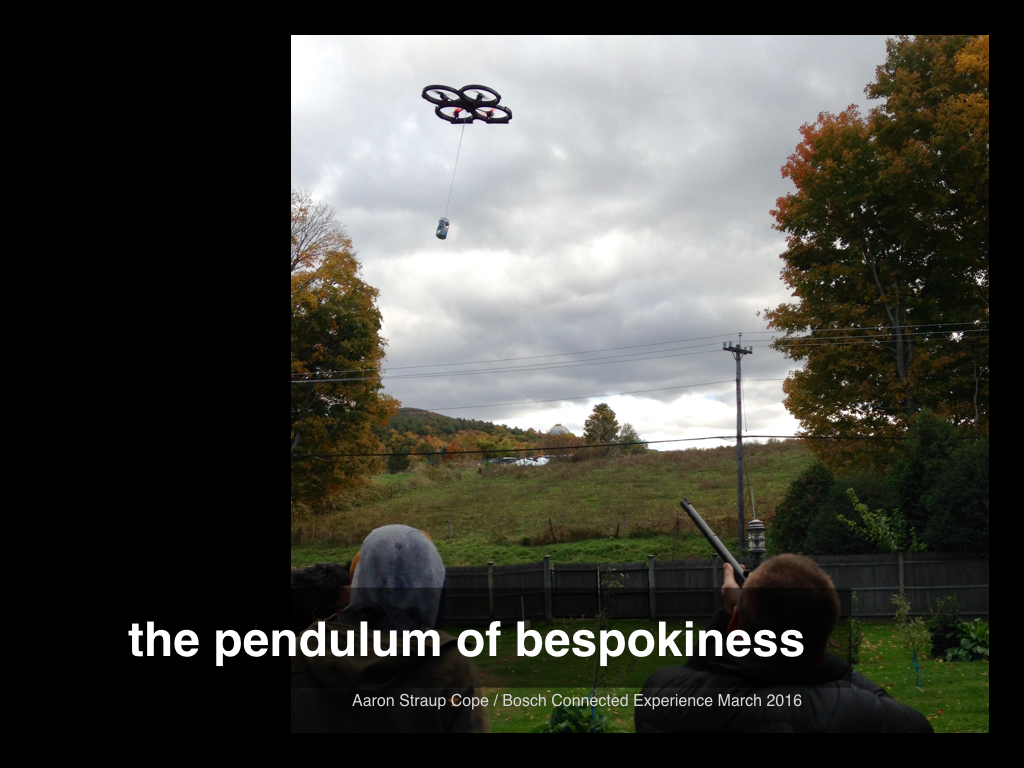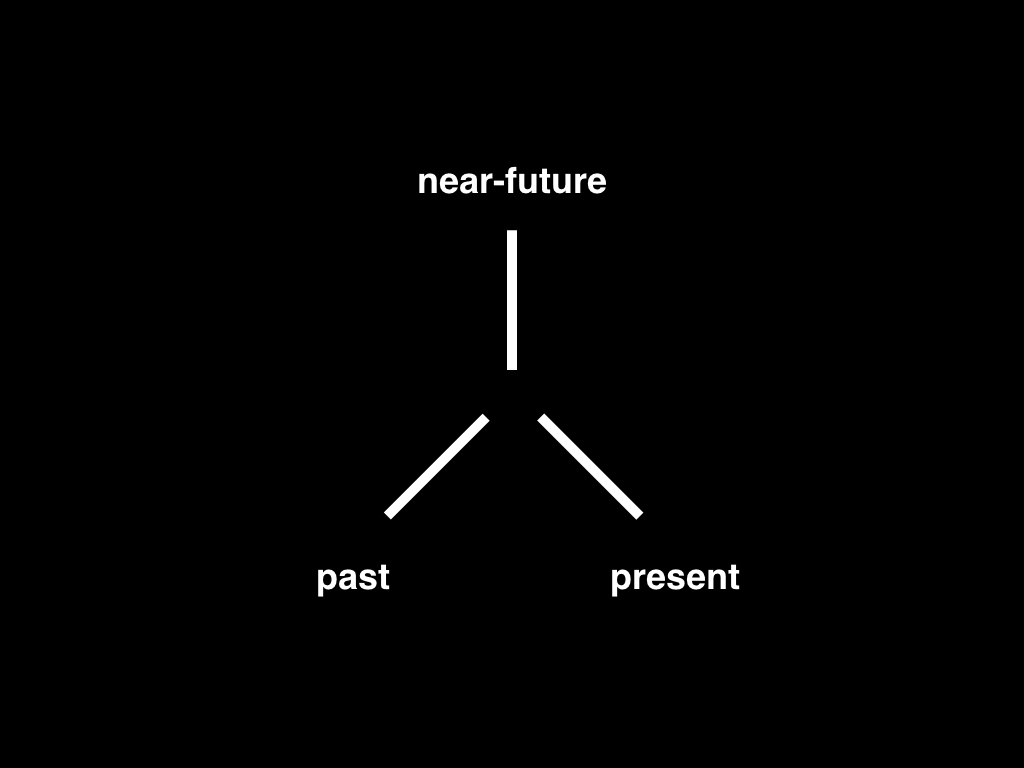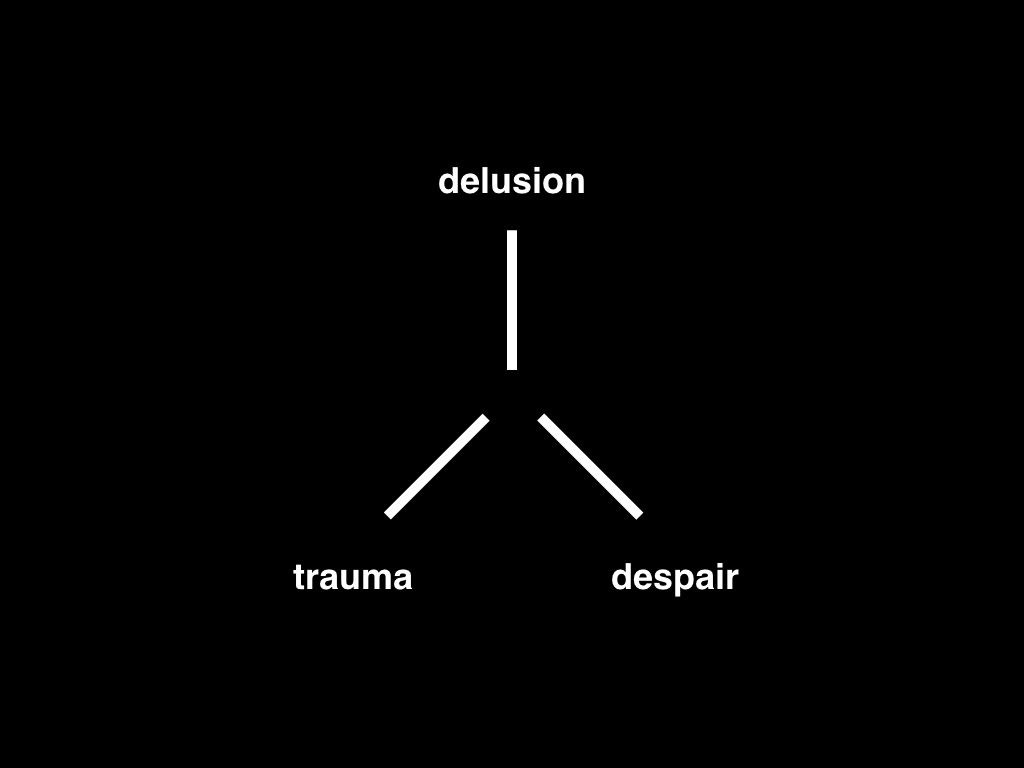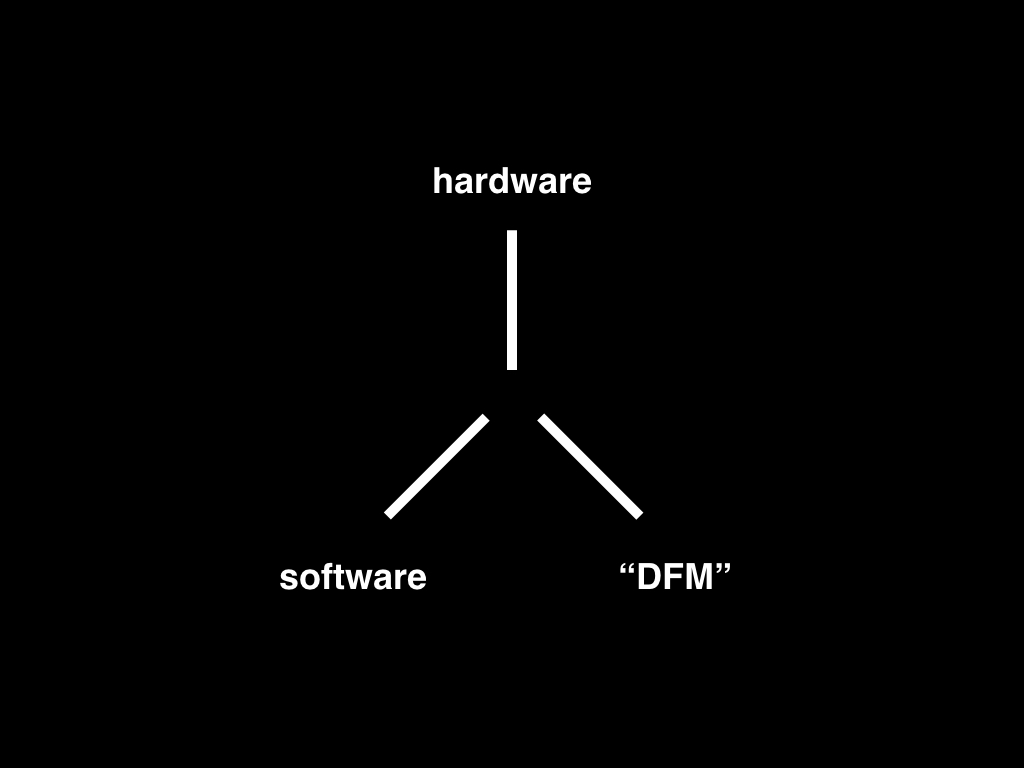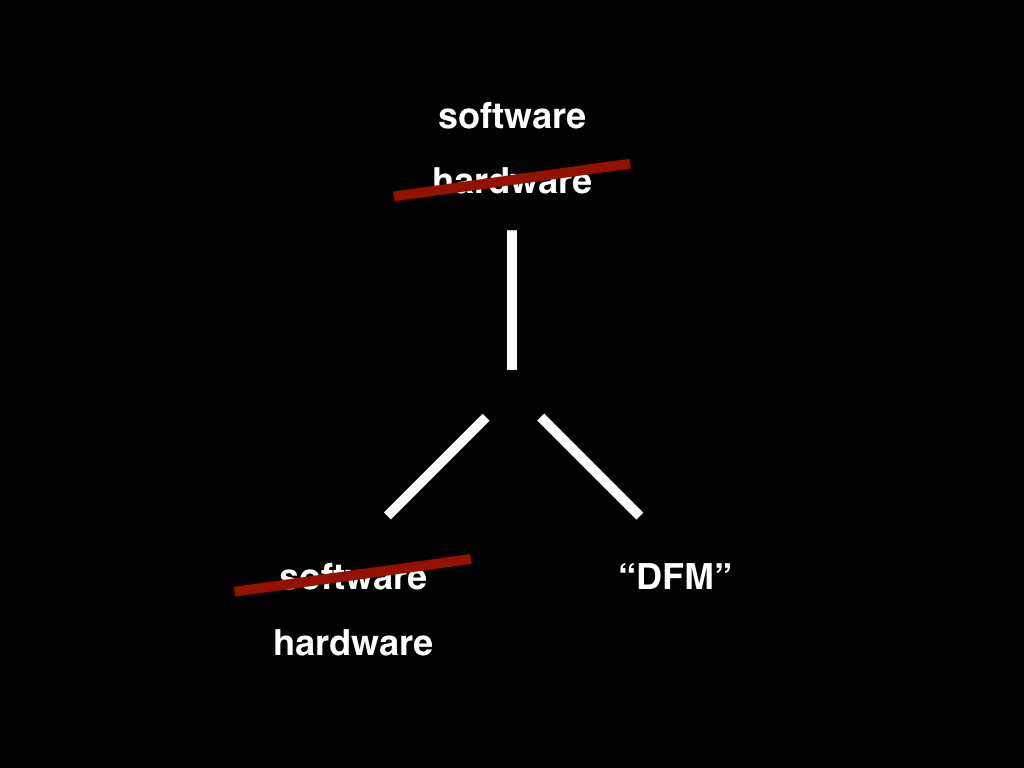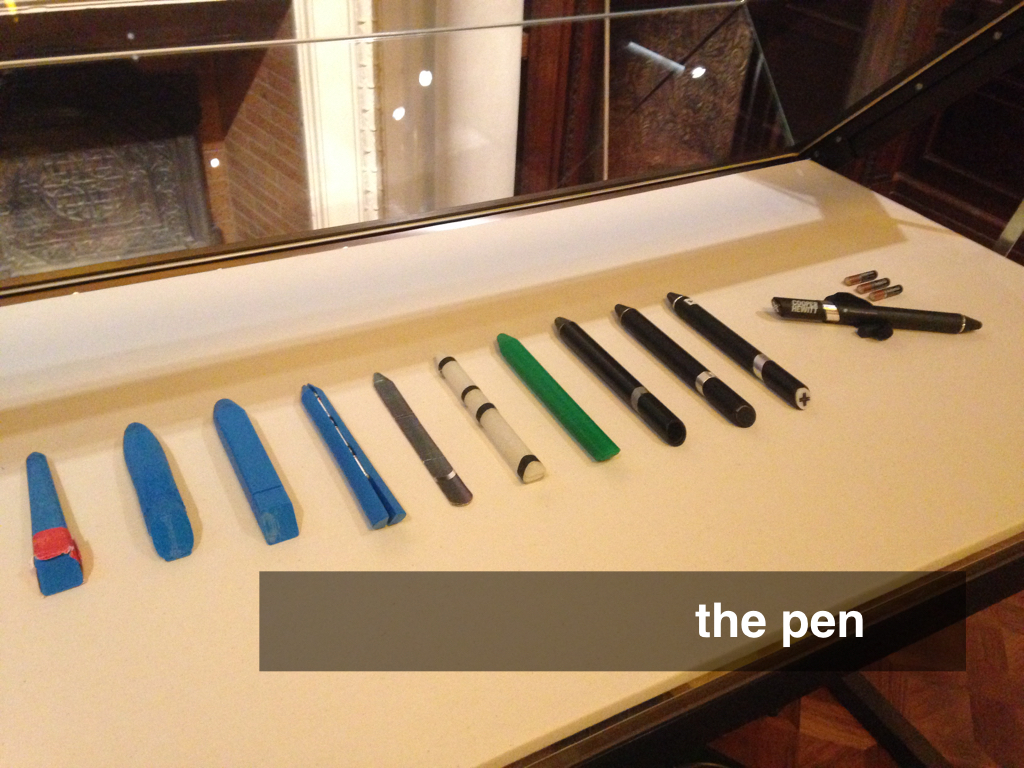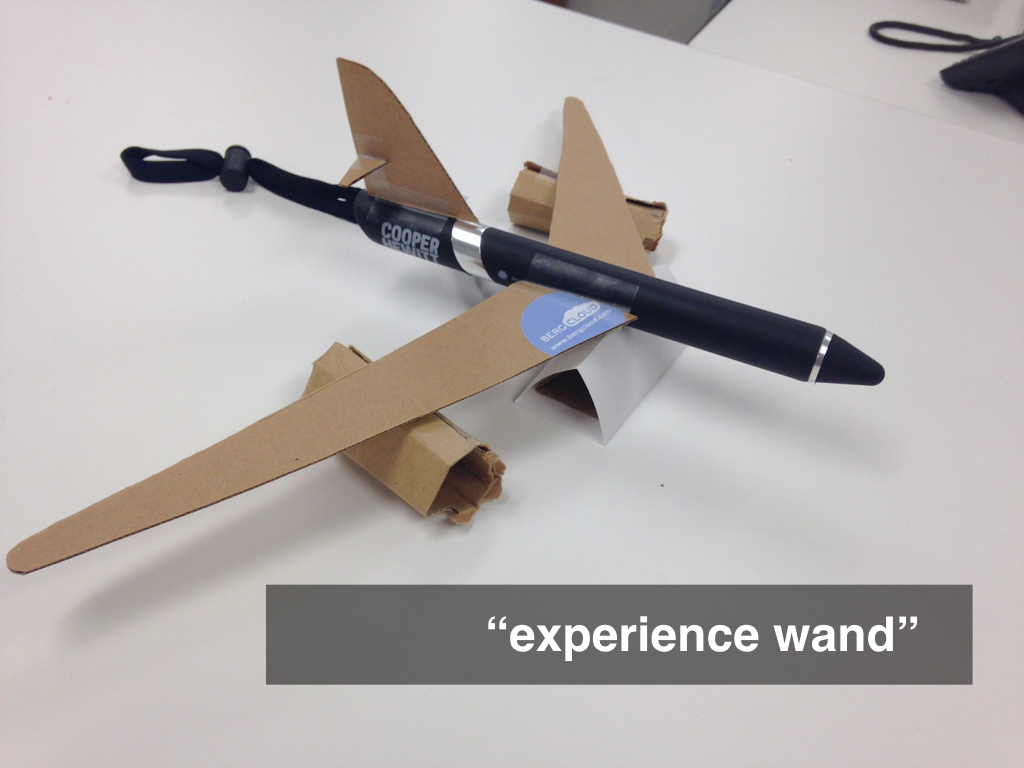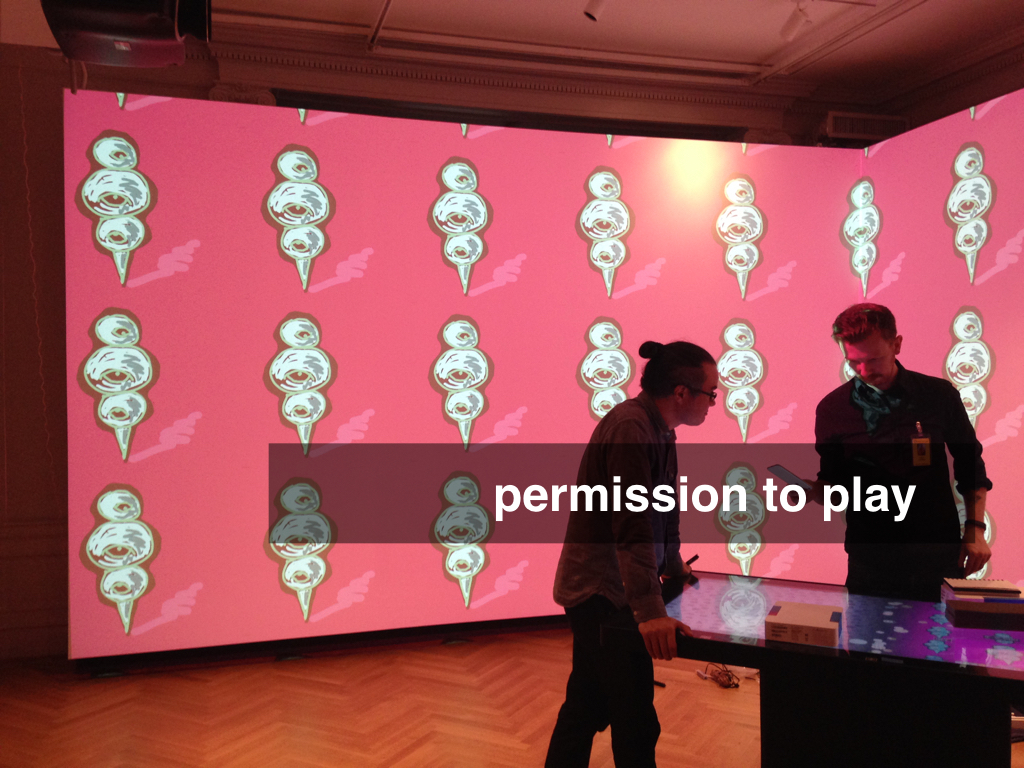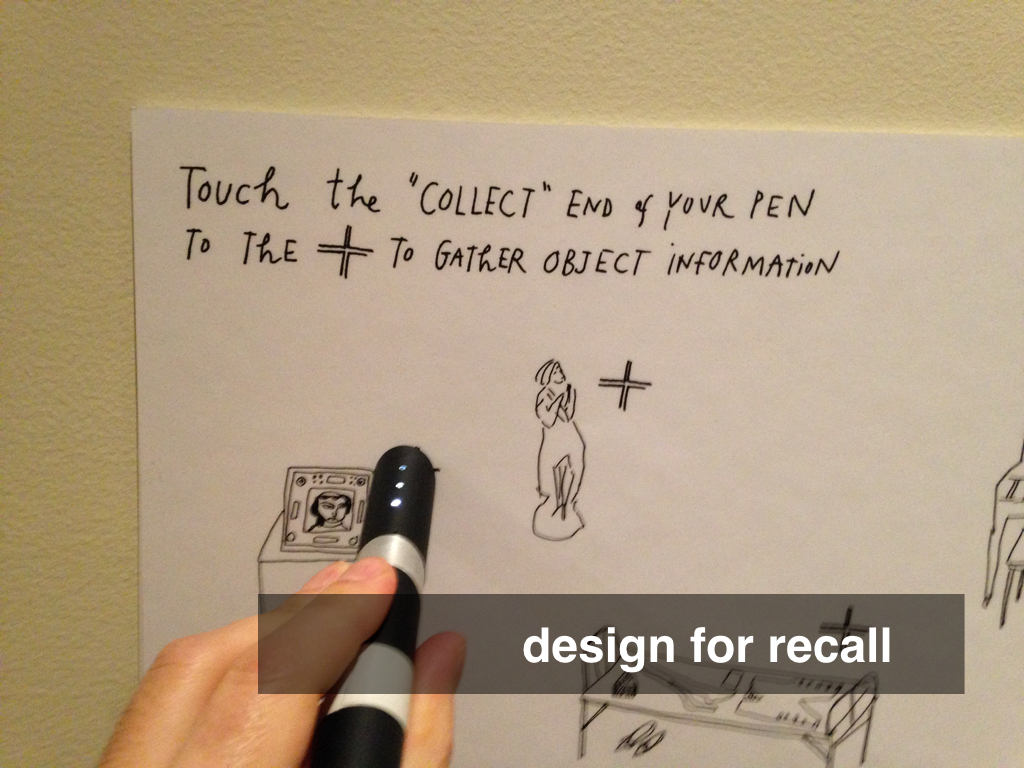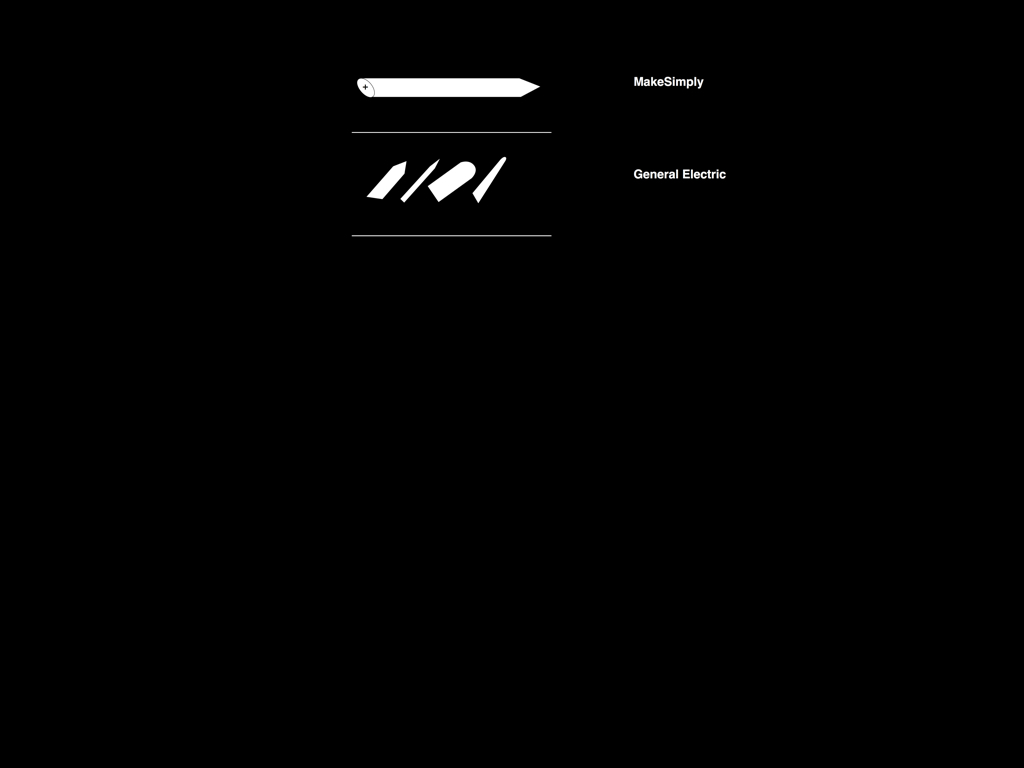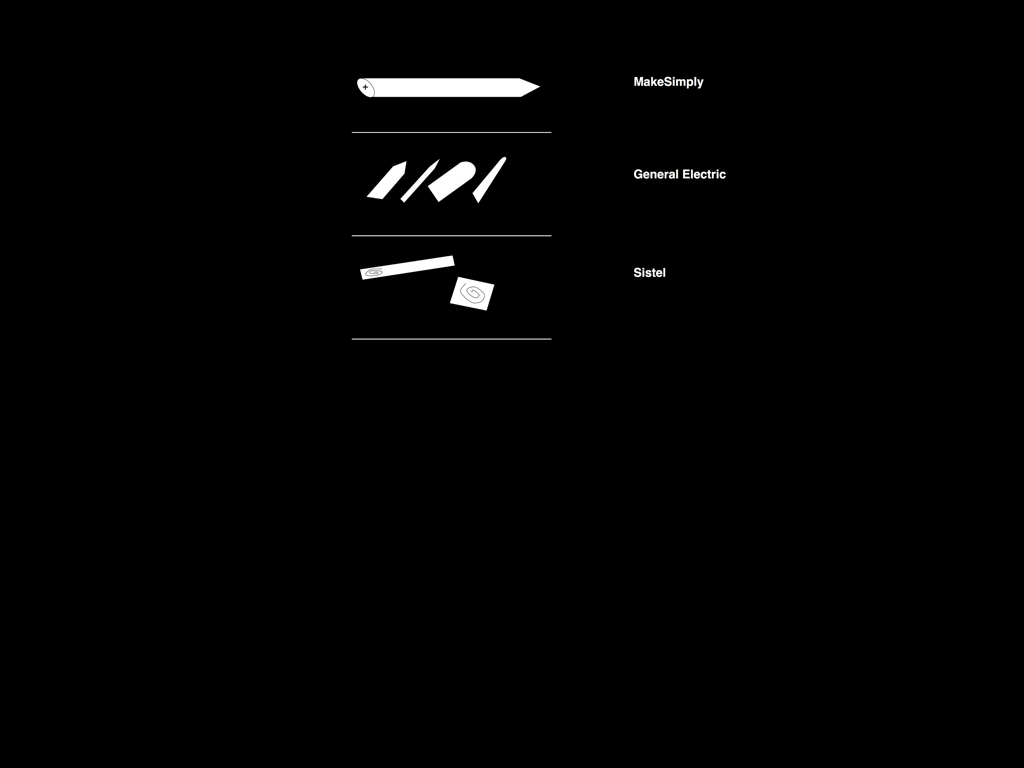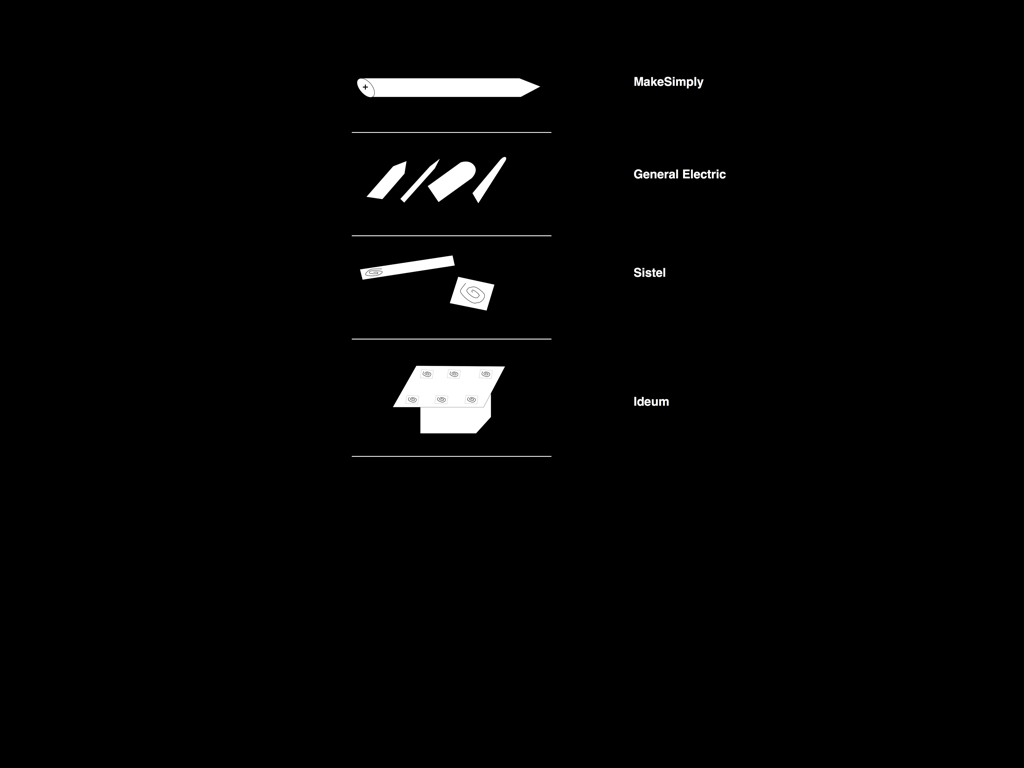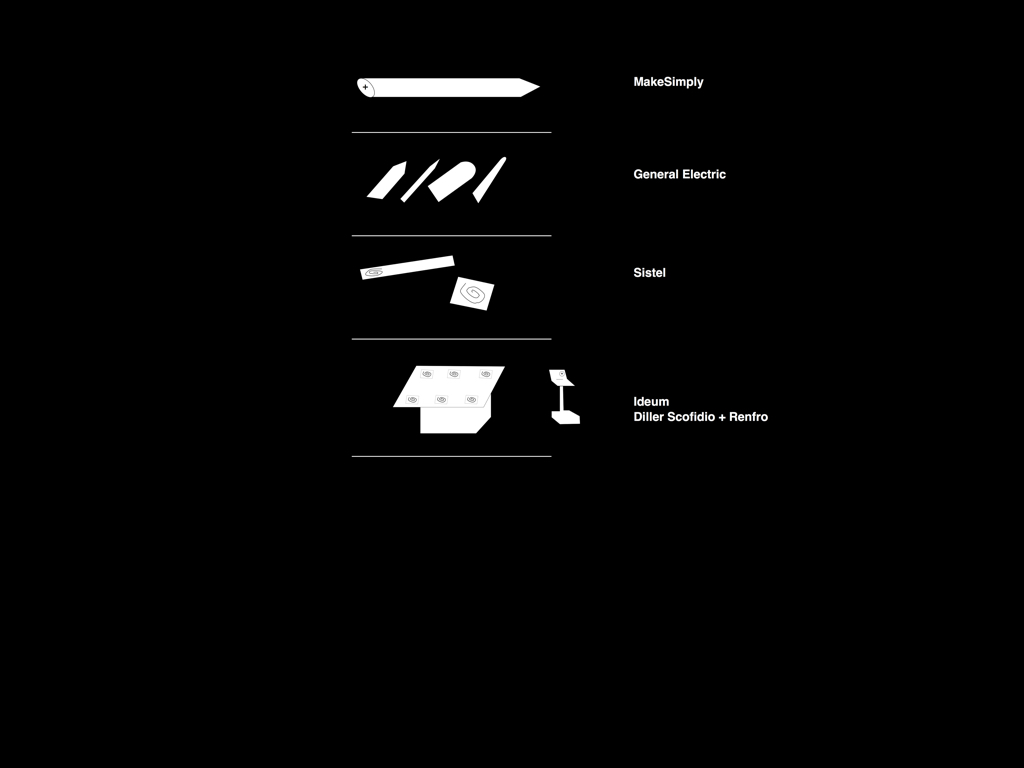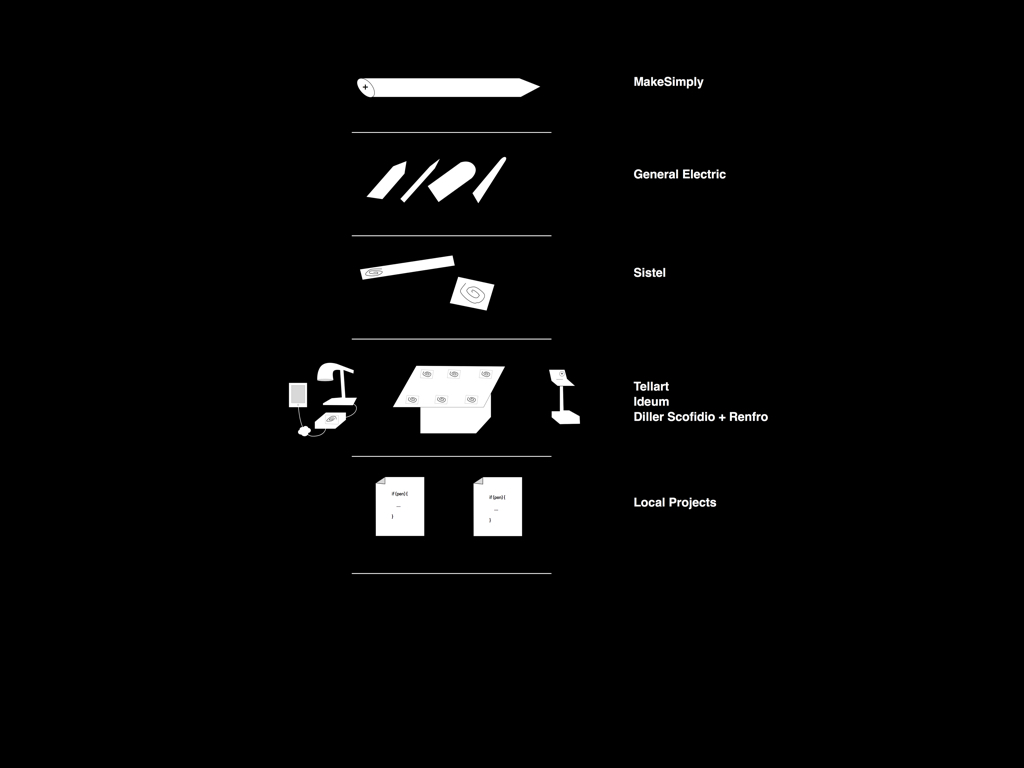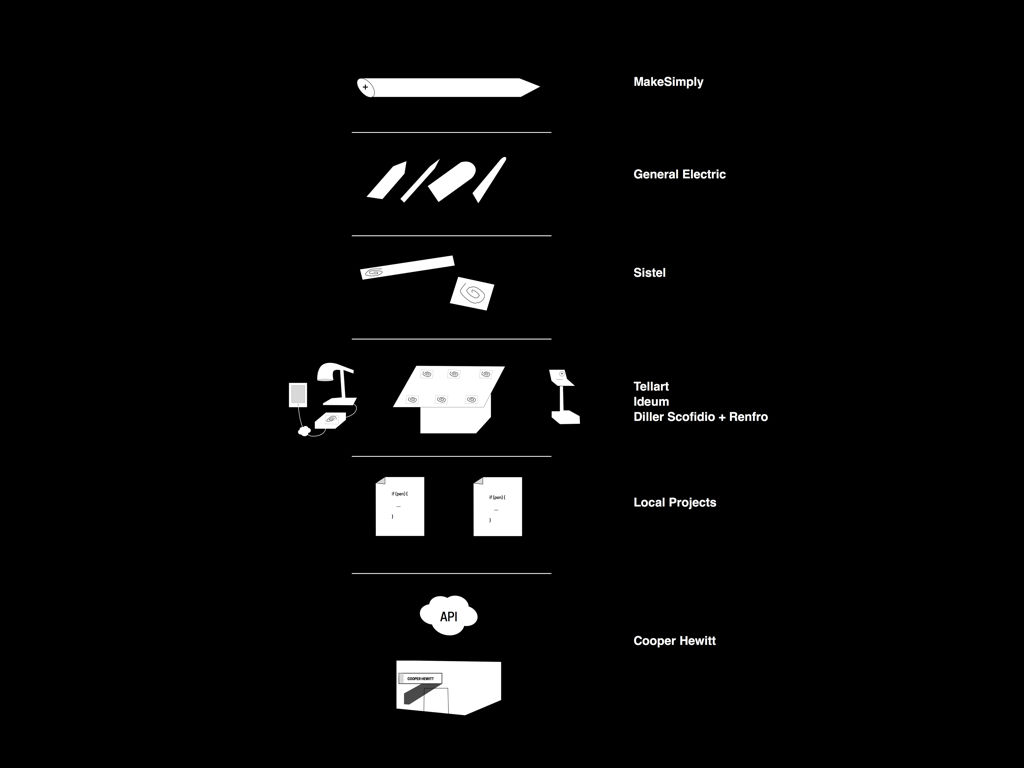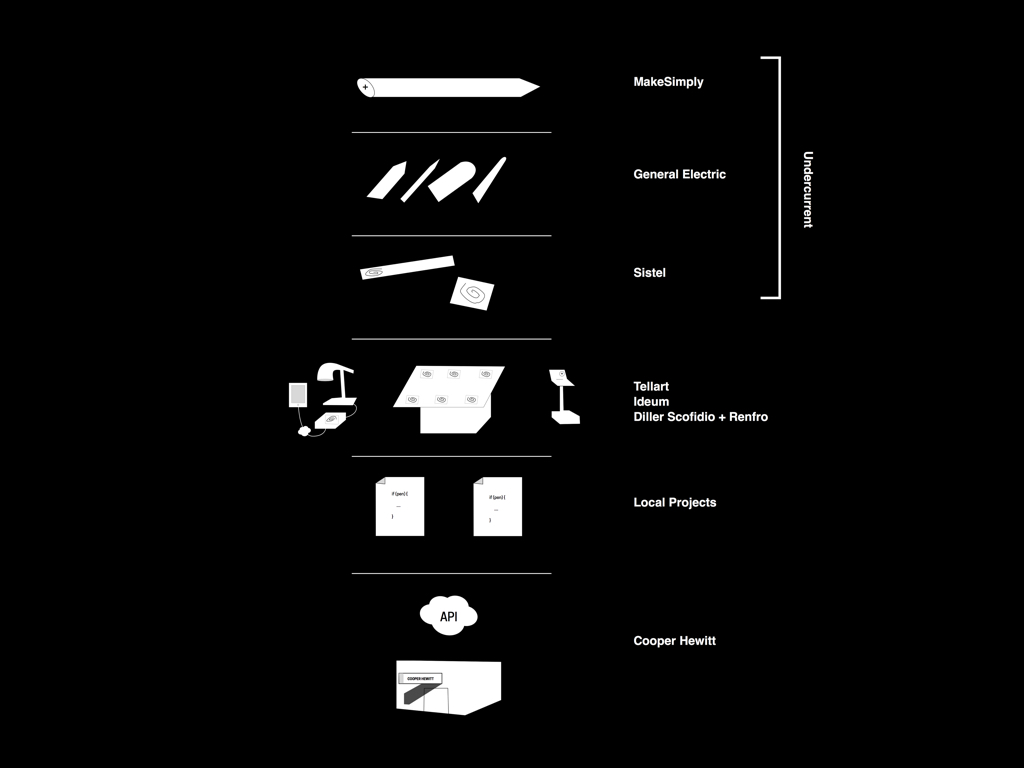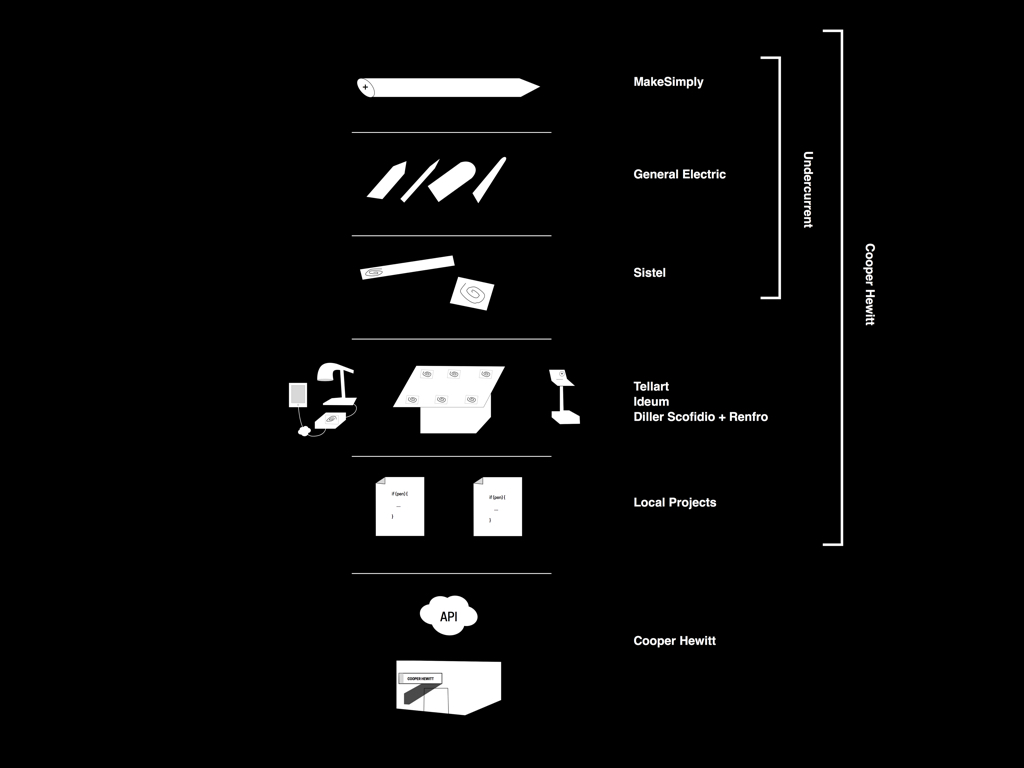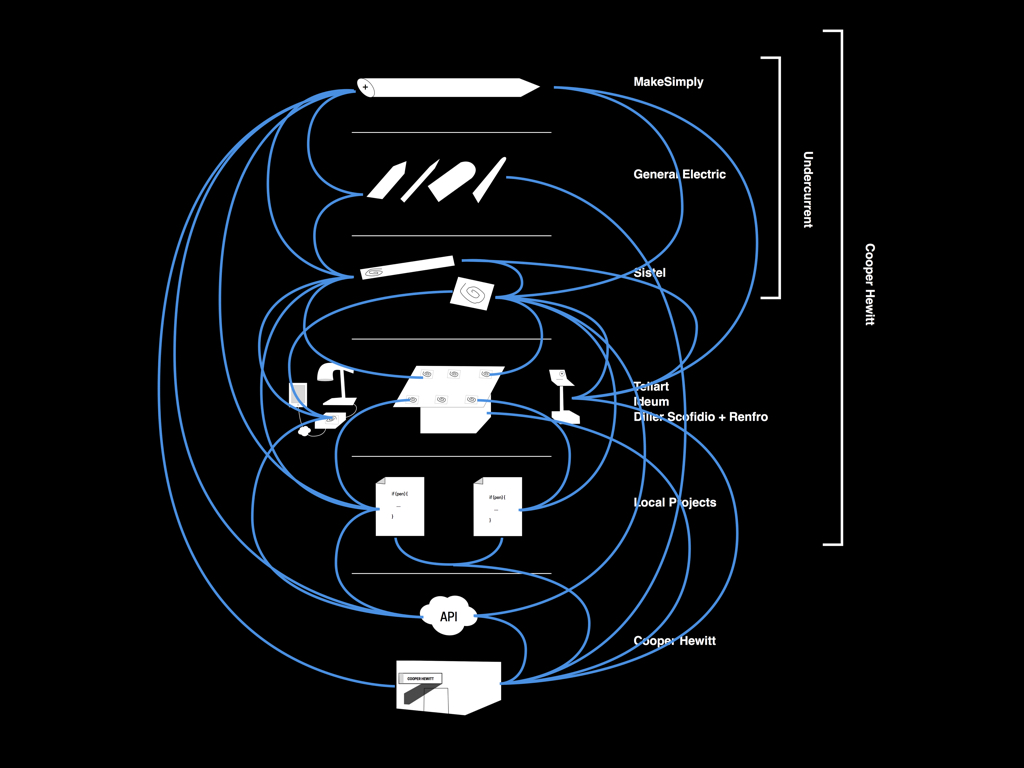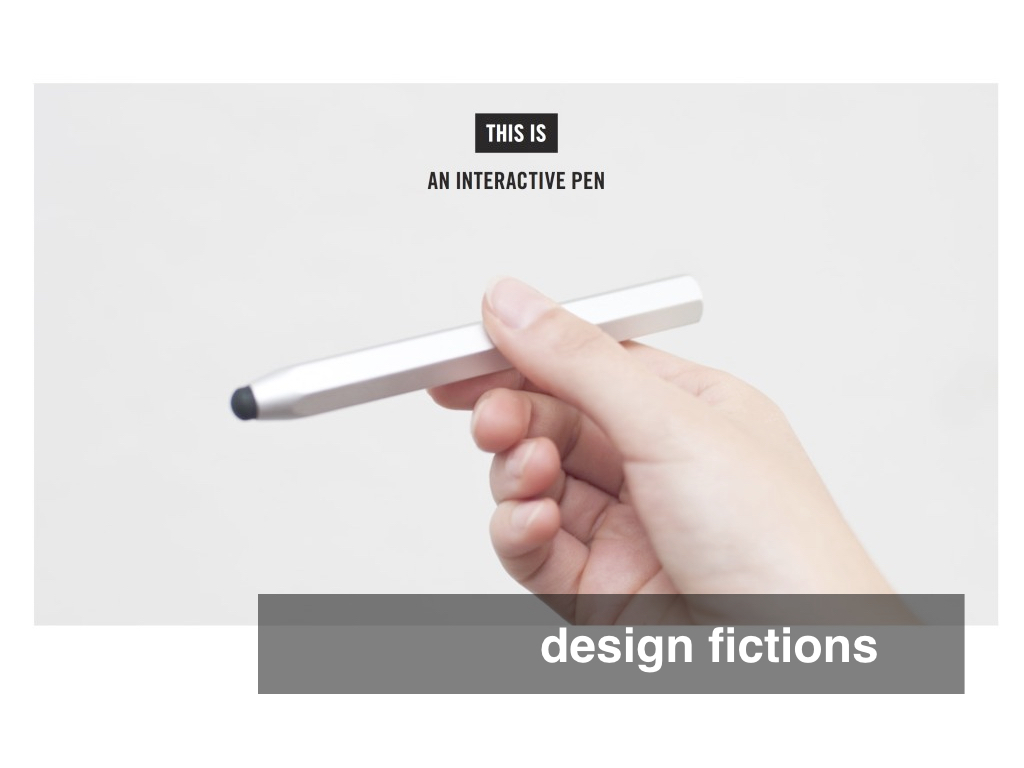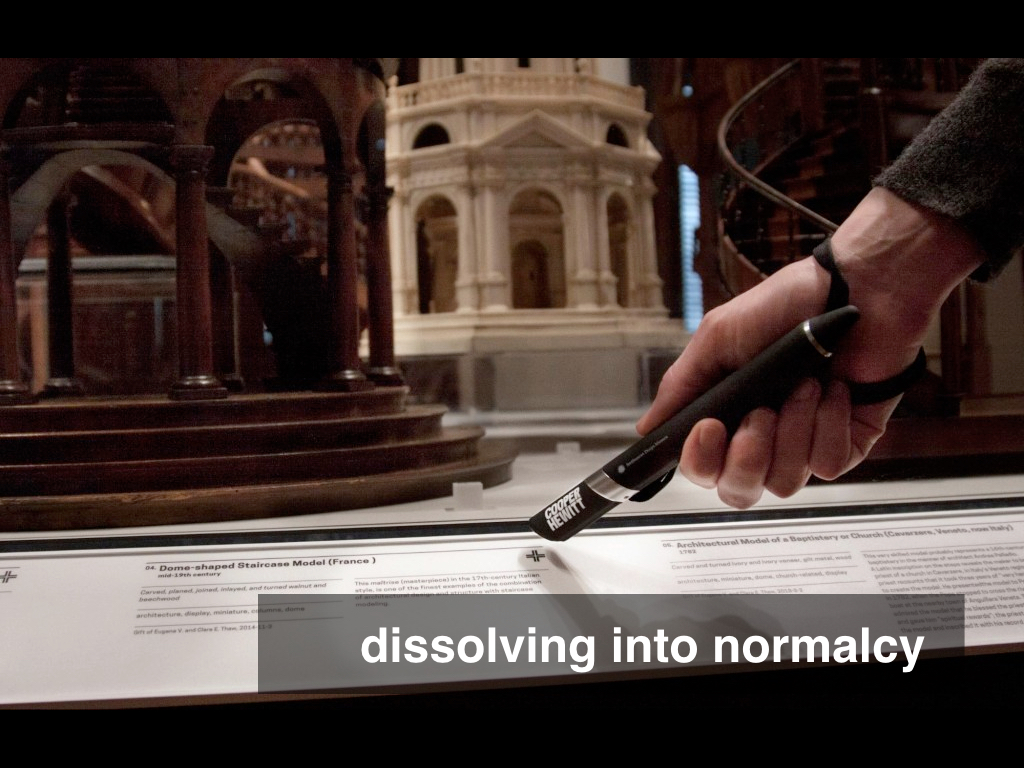The Pendulum of Bespokiness
Last week, I had the pleasure of speaking at the Bosch Connected Experience event, in Berlin. I spoke about the Pen, just in case you thought there wasn't anything left to say about it.
This is what I said.
Hello, my name is Aaron. These days I make maps but between 2012 and 2015 I was Head of Engineering and part of the Digital and Emerging Media team at the Cooper Hewitt Smithsonian Design Museum, in New York City.
Our job was to help re-imagine what it means for a museum, in the twenty-teens, to be a full citizen on and of the internet and vice versa. Some of that work is what I'll talk to you about today.
The title of this talk — The Pendulum of Bespokiness — is my reaction to the idea, the zeitgeist, that all devices and all their disparate functionalities are converging. Typically towards people's phones and more generally some kind of hub
.
I am not going to claim that it isn't happening but I would like to suggest that — however subtly or however gently — this trend has begin to swing the other way. This is the lens that I would like to use to look at the work we did at the Cooper Hewitt.
There is no way that I will be able to convey the complexity and the detail of all the work we did in a single talk. In addition to all the work that we on the Digital team did the museum was also closed for an expansion and an historic restoration and had plans to re-open with upwards of ten new exhibitions, simultaneously.
By my estimate something on the order of twenty to twenty-five thousand words have been written by and about the work we did at the museum, notably the Pen which I will come back to shortly. I have compiled an appendix with links to the relevant writings and it can be found at this URL.
I will show this link again a few more times during the talk.
I'd like to start with a pretty benign diagram, one that borders on the banal. The intersection of these three forces is the territory where most human endeavour happens.
The near-future is the place that we are all, in our separate projects, working towards. The details may change but the ambition remains the same. It is the horizon of the almost-reachable and nearly-there possibilities that acquire a kind of hyper-clarity born of past experience (usually failure). The present is the uneasy terrain between those two poles.
The present is also the place where the boundaries between one's own past and near-future are reimagined, sometimes redefined beyond recoginition, by other people.
Here's a more concrete example.
In 2016 we more or less have a handle on building large, networked software systems. It's not perfect but neither the heavy-lifting or the economics of these kinds of projects lend themselves to immediate dread or panic anymore.
In 2016 we do not enjoy an equivalent facility with hardware, specifically electronics, but the costs are shrinking rapidly. Every couple of years seems to knock a zero off the total cost of hardware development so that's progress.
In 2016 industrial design, tooling, manufacturing and the complex interplay and demands of material properties — a process sometimes refered to as design for manufacture
or DFM but what Bryan Boyer once aptly described as matter battle
— remains the place where everyone still goes to be sad.
In fairness to the experiences of the people in this room that last slide could be reconfigured to look like this but even here DFM is the meat-grinder of reality where all projects go to meet an uncertain fate.
This was certainly our experience at the museum, anyway.
Because we made a digital pen, from scratch.
We made a pen that is actually an NFC-enabled capacitive stylus. It allows people to collect objects on display in the museum by tapping the pen to an object label, which itself contains an embedded NFC tag, and recording that object's unique ID.
The NFC antenna is activated when a button housed in the rear of the pen is pressed. The pen contains a circuit board with a small amount of on-board storage and an equally small microcontroller for recording the things the antenna sees.
The pen's only feedback mechanisms are a gentle vibrator and three small monochromatic lights. It is designed for 21 to 28 consecutive days of use on the floor before its three AAA batteries need to be replaced.
Every visitor to the museum is a given a pen that is then paired with their ticket which contains a unique short code (or URL). That code can be used to retrieve its corresponding visit online. A person might look at their visit's online dopplegänger while they are still in the museum galleries or from home, six months later. Or both.
Museums have the luxury of being patient that way, which is kind of a big deal.
The Pen (no longer simply just a pen
) was originally conceived of as a device — literal and metaphorical — to re-imagine the museum visit as something other than the usual experience where people march from one object to the next passively receiving the wisdom of the experts.
The Pen is meant to give visitors permission to play in the galleries. To give them permission to touch and in some cases to write on or affect maybe not the actual objects on display but certainly their digital representations. Throughout the museum there are a number of large multi-user interactive tables, each with custom-written applications, where you can browse more information about the objects on display as well as related objects from the collection. That's pretty important for a museum like the Cooper Hewitt which has two hundred thousand objects (or the larger Smithsonian which has 137 million objects) but only enough physical space to display about 700 of them at a time.
These applications also allow visitors to create, and save, their own designs. This is a photograph of the Immersion Room, probably the most popular part of the museum since the re-opening. The Immersion Room consists of an interactive table and a floor-to-ceiling projection where visitors can see the museum's vast collection of wall-coverings in a way that had never been possible before. They can also create their own wallpaper designs, drawing on the tables with the Pen or their fingers, and see them projected in real-time and at scale and then, as I've mentioned, save them to their online visit.
As much as the Pen was designed as a way to foster activity in the galleries — and dwell times have nearly doubled, sometimes tripled, since the re-opening — it was also explicitly designed as a way to extend a person's visit beyond the museum. So far it's worked pretty well.
The Pen, which was launched a year ago tomorrow, has been used by visitors to collect objects four million times. It enjoys conversion rates that would make Silicon Valley companies weep. I don't have the current numbers but when I was still at the museum we saw conversion rates of 20 and 30 percent, respectively, for people looking at their online visit within the first two weeks and then creating a Cooper Hewitt account.
The other important number is that visitors have collected something in the neighbourhood of 5, 000 unique objects. Remember how I mentioned that the museum only has space to display 700 objects at a time in the galleries? The goal of anyone who says museum
and digital
in the same breath has always been to find meaningful bridges between the analog and digital and the Pen appears to be doing something right in that regard.
Naturally when we started with the Pen concept in 2012 we assumed that a device such as we were imagining must already exist.
Naturally it did not, or rather if it did exist it existed to operate only under conditions and circumstances entirely unsuited for the realities of a busy museum with a heterogenous audience.
Naturally we found ourselves doing full-on product design, with a lot of help from friends and partners. Product design is not only outside the comfort zone of museums, it is also outside our experience.
For a design museum though it was a good and healthy albeit challenging experience. For a design museum that celebrates process there is value in reminding oneself that things don't just magically transition from napkin sketch to finished product.
What follows is a list of the people involved in the project and a few of the matter battle
highlights, starting with the finished Pen and working our way down the stack.
MakeSimply is a manufacturing company and broker based out of Taiwan and the US. They did all the mechnical engineering, tooling, assembly and herding of cats involved in any project that requires twelve separate factories.
The most complicated parts of the Pen are at the ends, but the center is pretty straightforward. It's a tube in to which you slide a circuit-board and three batteries. The capacitive sheathing is applied using a process called overmolding where one material (the capacitive sheathing) is heated to the point of being viscous and then sprayed on to another material (the body of the pen) and left to harden in place.
So far so good, but then we got a call from MakeSimply one day. They told us that the overmolding was melting the then-plastic body of the Pen. The only solution was to use an aluminum body which caused the electronics people to have a little freak-out. More about that in a minute.
General Electric (GE) did all the industrial design for the Pen, including early prototype designs and all the finished UX work for the lights and haptic feedback on the Pen.
GE were great and they were very clear and upfront with us early on that they would not do DFM. It's not like GE can't do DFM but they are set up to do DFM for things like submarines and wind turbines not small, bespoke projects like ours. That was a learning experience for the museum.
Sistel Networks did all of the electronics and NFC-wrangling for the Pen and the antenna boards for shuttling information on and off the Pen.
They came up with the initial design concept for the button-activated radio which was instrumental allowing us to have a device that can go uncharged for three to four weeks. The Cooper Hewitt has, even by museum standards, a tiny staff. There are only 70 to 75 people across the entire institution so changing batteries, or simply recharging devices, every day was a non-starter.
To put the work that Sistel did to acheive this in perspective the circuit boards in the Pen don't even have a clock since that would have added a prohibitive drain on power.
Ideum designed and built all of the interactive tables, which came in three flavours: 32-inch tables for single-person use, 55-inch tables for small groups and 84-inches for larger groups and as a way for other people to learn how the tables worked simply by watching other people use them. Each one of the tables has one to eight built-in NFC antennae for communicating with the Pens.
Ideum builds things to withstand the continued abuse of small and young children in addition to absent-minded adults, in a museum setting, but sometimes you still have to create the future you want to use.
Which is to say that in the summer of 2014 the 84-inch tables were still a work-in-progress. An unfinished piece of hardware that the software developers had to accommodate and adjust to on a weekly basis. A thing that needed to be assembled before all the NFC hardware had been finalized. A thing that couldn't be moved out of the museum once it was determined that adjustments needed to be made because we had already started installing objects from the collection in the galleries.
Diller Scofidio + Renfro designed all the case-work in the museum. They are beautiful cases but one of the challenges they presented the museum with is that they are made of solid metal. Metal is, of course, the perfect enemy of all radio signals including NFC.
I'd like to take a moment to thank the entire country of Germany because apparently you are the only people who produce ferrite shielding, a material that can be used to dampen the interference between metal and radio signals. If you noticed a shortage of ferrite shielding in late 2014, or early 2015, that was probably the museum buying as much of the stuff as it could get its hands on.
Tellart designed the electronics for the Pen registration stations, used by the visitor services (or front of house
) staff for pairing a Pen with a visitor's ticket.
There is a whole other talk about just this piece, so I will simply say that the requirement for the registration stations is to allow the front of house staff to complete a ticket purchase and pair a pen for visitors, many of whom don't know anything about the Pen or who then want to have a conversation about it, in under 30 seconds.
Local Projects designed and wrote all of the software for the interactive tables.
There aren't any specific matter battle stories for Local Projects. They were more about the software side of things than the actual hardware. That also means they were on the receiving end, with fixed-date deliverables and their reputation on the line, of everyone else's hardware challenges. If product design is outside a museum's confort zone the way the Pen came together and the way it forced everyone to work together is equally outside the comfort zone of many client-services design studios.
Finally, the Cooper Hewitt. In 2012, when the Digital and Emerging Media team was created, we took all museum related software development in-house. The net-result of this process was to say to every third-party who wanted to do anything with Cooper Hewitt related data that they would do so using the museum's own API.
We, not yet-another custom black-box database, would the single source of truth for all things museum-related. The building, by way of the interactive tables and the Pen, is now the single largest consumer of the museum's own API.
Moving away from the hardware side of things, Undercurrent, the now sadly-defunct strategy firm in New York City, lent us Jordan Husney to help oversee and manage all the moving pieces in getting the Pen out the door.
The Cooper Hewitt was its own general contractor, managing and buffering and sometimes cajoling all the pieces in the same direction. Not shown here are the even more complex layers of pain required to do budgeting and contracts inside the federal government. The Cooper Hewitt is part of the Smithsonian which is a trust instrumentality
of the US government so it is bound and subject to everything you've ever heard about government contracting and purchasing agreements. That was fun.
And this is how it all fit together. There is also a full-sized 4K version of this diagram if you're curious.
It is important to understand that most of the actual work you see described here happened in one very compressed, very manic and very difficult twelve month period between February 2014 and February 2015. Planning and design meetings, as well as the digital infrastructure work that the Cooper Hewitt itself was responsible for, had been underway since 2012 but the Pen proper was born in a crucible of bad craziness where each partner was forced to adapt and adjust to the demands and changes imposed by every other partner, all at the same time.
Almost no one involved with the Pen was happy for most of that year.
The bad news is that no one should ever try to do things the way we did. We did things this way out of necessity but ours should not be the template for how to do product design.
On the other hand, the good news is that it is totally possible to imagine, design and manufacture something like the Pen inside of a year which is pretty exciting. It's still hard and still not cheap (but actually a lot less expensive than you might imagine) but it is possible.
So, why did we do it in the first place?
We did it because of this. This is the slide that set the whole project in motion, back in mid-2012. The museum had given its exhibition designers license to imagine what an interactive museum experience might look like beyond simply another kiosk or mobile app
.
This is what they came back with. They came back with this idea of giving every visitor an interactive pen as a way to invite them (and to challenge the museum) to think of the museum as a participatory experience.
The Cooper Hewitt is a design museum and, for a museum anyway, design is as much about the process as it is about the finished object so the idea of an object (the Pen) that embodied this principle was fascinating.
But as intrigued as we were by the possibilities of a proactive device it was the other affordances that the Pen suggested which really spurred us on.
What if it were possible for someone to visit the museum and have a record of that experience without, and this is important, having to spend all of their time actively engaged with technology in order to do that?
What if a person could simply reach out and touch an object, or its label, to collect it? It's pretty easy to imagine that possibility but it turns out the Pen is still, in 2016, the minimum required hardware in order to actually do that outside of burning away the details with an irresponsible amount of money.
Along the way many people asked us why we didn't just create a mobile app to record a person's visit. There are many reasons but even if the only reason had been cost (the cost of developing for multiple platforms and then the ongoing maintenance costs) we still would have said No
.
We would have said no because we wanted to ensure, to preserve, what we spoke of internally as a heads up
visit. The point of visiting the museum is to allow people an opportunity to focus on the collection, not the technology.
If the technology only serves to delegate the collection to a supporting-cast role then perhaps there is a larger problem with the entire museum project itself.
The Pen does as little as possible because you are not meant to be dazzled by the technology, at least not the second time you visit the museum.
You are meant to be able to take the Pen for granted because, ultimately, you are meant to be able to take for granted what the Pen makes possible: The luxury and the confidence of recall (your visit) at the time of your own choosing.
The Pen is not a device meant to surpise you. We leave that to the collection.
We live in a world with enough technological surprise as it is.
In 2016 the cognitive overhead of not simply understanding what an object does but what an object might do, particularly when it is connected to the internet is overwhelming, on good days. On bad days it can feel like a betrayal. By way of example let's just pick a few recent headlines from the news:
- The Nest thermostat and its failed software update over the holidays that left a number of people without heating, in the middle of winter. Bugs happen and even hardware fails. I once spent nine hours without power in minus 30 degree weather when a single transformer in Northern Quebec exploded one night and plunged three quarters of the province in to darkness. What I find striking about the way people talk about the Nest incident is that they are starting to question what the point is, what the benefits are, of making something as simple and useful as a thermostat
smarter
. - Meanwhile, the head of the intelligence services in the United States has said in no uncertain terms that they will use the
internet of things
as a platform for spying on people. Everything you here in this room are working on will be repurposed, wholesale, as surveillance pipes. - Finally, and I apologize in advance if this is a trigger word for some people in the room, there is Volkwagen's so-called
defeat device
software that is deliberately programmed to lie about a car's fuel emmissions. If the other examples are the domain of nerds and people wearing tin-foil hats then the VW fiasco is the place where everyone else is looking at the evidence and starting to ask just what the fuck is going on? It is difficult not to see thedefeat device
as a slap in the face to the entire notion of a social contract.
Trying to find your bearings, trying to make sense out of all these crosscurrents is dizzying and I don't have a pat answer for any of it. I would like to finish, though, by arguing that these ambiguities are what constitute the present
for the internet of things.
The lack of clarity around, and in some cases the hijacking of, the reasonable expectations of action and reaction in an internet of things is what is and what will shape and redefine the relationship between the past and near-futures of the internet of things you have imagined for so long.
This is the work.
This blog post is full of links.
#bespokiness